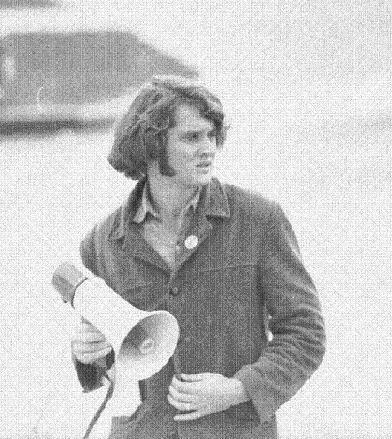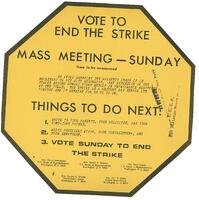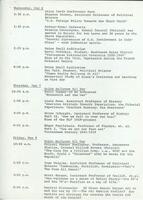"DO Something About It!": The 1970 Student Strike
SDS would have some continuing influence over the next few years after Davidson and Steve Abbott left UNL. The CFDP changed its name soon after the two student activists left, not wanting to be associated with Davidson's radically syndicalist ideas, and continued promoting a Student Bill of Rights. [27] Draft resistance, which had been controversial when SDS first took the position, again became a major issue when Dr. Marxer, a professor of philosophy, attempted to form the Nebraska Draft Resistance Union in 1968. [28] The NDRU lasted only a short while. Calls for Marxer to be fired and charged with treason were made in letters to Chancellor Hardin and to the local newspapers. [29] The Board of Regents decided, rather than spark a free speech controversy by firing Marxer, to let his contract expire without renewal that summer. The University chapter of SDS saw many of its members put their energies towards the 1968 presidential campaign of the peace candidate, Eugene McCarthy, and the group became less active on campus. In 1969 ideological disagreements within the national organization became full blown, SDS split apart into competing factions and then dissolved.
The campus, however, became less apathetic and increasingly political despite the loss of SDS. A chapter of Young Americans for Freedom, a conservative campus group that had often opposed SDS (and on occasion worked with SDS) at universities across America, was established. The Vietnam Moratorium Committee formed a chapter on campus in the fall of 1969. ASUN President Steven Tiwald became heavily involved in the National Student Association, which had become increasingly against U.S. involvement in Indochina over the years. A variety of ad hoc political groups and coalitions would form over the next few years until the end of U.S. involvement in the Vietnam War.
The biggest antiwar protests on campus happened, as they did at hundreds of other colleges across the nation, when President Nixon announced the invasion of Cambodia on April 30, 1970. The Vietnam Moratorium Committee, working with ASUN and Steve Tiwald, immediately went into action to form a demonstration. [30] Fliers appeared with the question "Angry about what Nixon's doing in Cambodia? Be outside the union (north side) 1:30 Monday May 4 And DO Something About It!!!" [31] The rally took place in the plaza of the student union, where a Hyde Park-style open microphone was in use. Two students used the microphone to call for a march on the Draft Board office at the Terminal Building on 'O' Street, a short walk from campus. Many others followed, including Professor Stephen Rozman, who would be criticized for his actions during the student strike. Two police officers prevented an estimated 75 to 150 students from entering the 9th floor office. As more police arrived, the demonstrators were ordered to leave, and 13 were arrested (11 for failing to disperse, 1 for property damage, and 1 for obscene language). [32]
Nearly 200 students met that night on a campus ministry, along with a few members of the faculty, including Dr Rozman. This group made plans to occupy the ROTC building (the Military and Naval Sciences building), and around 100 promptly did so. Police had suspected the building would be a target for some kind of protest and had a few officers on the scene beforehand. However, these officers proved incapable of keeping the students out. The students had taken control of the building. University administrators immediately took action to remove the students, including an attempt to get a legal injunction on the protest in the middle of the night, with ultimately no effect. Within hours, the crowd of occupiers had swelled to 1,800. [33]
A group of students who had assumed the role of spokespeople for the demonstrators drew up a list of demands, which was later published in the Daily Nebraskan. These demands included amnesty for those arrested at the Draft Board; that the administration endorse the strike; that ROTC be suspended until the end of the war (this was amended from an earlier version calling for abolition of the ROTC); that campus police no longer carry guns on campus; that meetings of the Board of Regents be public; and that free University classes get one hour of credit towards degrees. [34] None of the demands were immediately accepted though some have become a reality in the years since, including the demand that Regents meetings be made public and campus police no longer carry guns.
By 10 a.m. the next morning, after the numbers of occupiers had decreased to an estimated 200 and with the administration threatening suspension, the remaining students vacated the building to attend an ad hoc faculty meeting at the Student Union. [35] But the strike continued for the rest of the week. Rallies were held often including one for the victims of Kent State, where four students had been shot by the National Guard on May 4th, a town hall style meeting of students which attracted thousands on May 5 (a similar rally would be held for the 2 black victims at Jackson State on May 15), and another rally of thousands on May 9 was put together by students, Rural Nebraskans for Peace, and Nebraskans for Peace. The next day, at another town-hall style meeting, a vote was taken on whether or not to continue the strike. ASUN had set up a variety of events called the "Czechoslovakian Spring Festival" (likely a reference to the Prague Spring of 1968) to educate students about the war and its history. [36] Young Americans for Freedom had been actively urging faculty to oppose the strike. [37] At the same time an ad hoc group called the Committee for Undisrupted Education distributed yellow "stop sign"-shaped fliers calling on students to vote against continuing the strike. [38] CUE succeeded in its efforts, with the vote being 1,357 against the strike and 1,030 for the strike. [39]
Little disciplinary action was taken. The Report of the Board of Regents on the "campus disruption" (which found little was actually disrupted, including classroom attendance) described the actions of university administrators, Dr. Rozman and other faculty aiding the student strikers, and the students themselves as "improper." [40] Despite not having a required constitution, the Vietnam Moratorium Committee had functioned as any other organization until a month after the strike, when the university no longer considered them to be a Recognized Student Organization. [41] Additional reports on the strike were created by the CUE in the fall. [42] In the wake of the campus demonstrations, occupations, and riots which had occurred, President Nixon introduced a plan for an increased role and presence of the FBI on campuses, which led South Dakota Senator George McGovern to send a letter and questionnaire to many university administrators, including UNL President Joseph Soshnik. [43] Little seems to have come from that effort and FBI surveillance and harassment of dissidents was, to some extent, curtailed following in the mid-Seventies.





